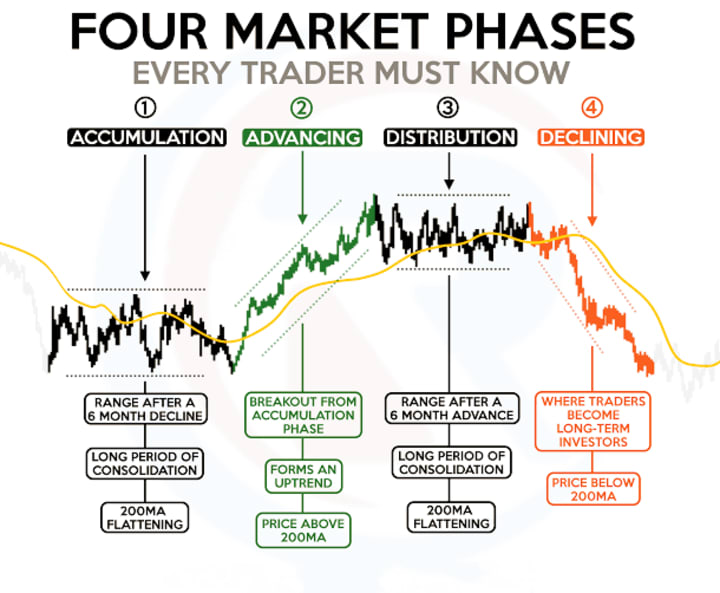what are the stages in the share marketing Cycle
4 main stages of a market cycle

The market cycle is a recurring pattern that describes the behavior of financial markets over time. It consists of four stages: accumulation, advancing, distribution, and declining. Each of these stages has distinct characteristics and signals that can help investors identify opportunities and manage risk.

Accumulation phase
The accumulation phase is the first stage of the market cycle. During this stage, the market is characterized by low trading volume and low prices. Investors who recognize the potential for future growth begin to accumulate positions, typically buying stocks or other assets at a low price. This phase is often accompanied by a general feeling of pessimism or skepticism about the market's prospects.
One of the most important signals of the accumulation phase is a series of higher lows in the market's price chart. This pattern indicates that demand for stocks is increasing, even as prices remain low. Investors who are able to identify this pattern may be able to make significant profits when the market enters the next stage.
Advancing phase
The advancing phase is the second stage of the market cycle. During this stage, the market experiences a significant increase in trading volume and prices. Investors who bought during the accumulation phase see their investments rise in value and may be tempted to take profits. However, many choose to hold on to their positions, anticipating further gains.
The advancing phase is characterized by a sense of optimism and enthusiasm about the market's prospects. This can lead to a self-reinforcing cycle of buying and selling, as investors jump on the bandwagon and try to ride the market's momentum. This phase is often accompanied by high volatility and frequent news headlines about the latest market trends.
One of the most important signals of the advancing phase is a series of higher highs in the market's price chart. This pattern indicates that demand for stocks continues to outstrip supply, driving prices higher. Investors who are able to ride this trend can make significant profits, but they must also be prepared for the possibility of a market correction.
Distribution phase
The distribution phase is the third stage of the market cycle. During this stage, the market experiences a decrease in trading volume and a plateauing of prices. Investors who bought during the accumulation and advancing phases may begin to take profits, leading to a decrease in demand for stocks. At the same time, new investors may be hesitant to enter the market at such high prices.
The distribution phase is characterized by a sense of uncertainty and caution. Investors who are able to recognize the signs of this phase may begin to adjust their portfolios, selling positions that are at risk of declining and moving into more defensive assets. This can help to protect their gains and prepare for the next stage of the market cycle.
One of the most important signals of the distribution phase is a series of lower highs in the market's price chart. This pattern indicates that demand for stocks is weakening, even as prices remain high. Investors who are able to recognize this pattern may choose to take profits and wait for a better buying opportunity.
Declining phase
The declining phase is the final stage of the market cycle. During this stage, the market experiences a significant decrease in trading volume and prices. Investors who held on to their positions during the advancing and distribution phases may see their gains wiped out, as prices plummet. This phase is often accompanied by a general feeling of pessimism and fear about the market's prospects.
Investors who are able to recognize the signs of the declining phase may choose to sell their positions and move into defensive assets such as cash or bonds. This can help to protect their wealth and prepare for the next cycle. However, it is important to note that not all market declines lead to a full bear market, and it can be difficult to time the exact bottom
About the Creator
Emmanuel Andrew
"I am a blogger and researcher who loves to write content about adventurous experiences and knowledge to share with readers. With a passion for writing and a love of travel, I seek out fascinating new perspectives."






Comments
There are no comments for this story
Be the first to respond and start the conversation.